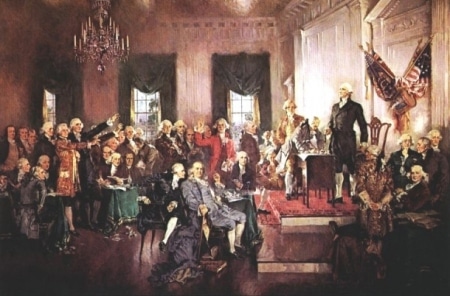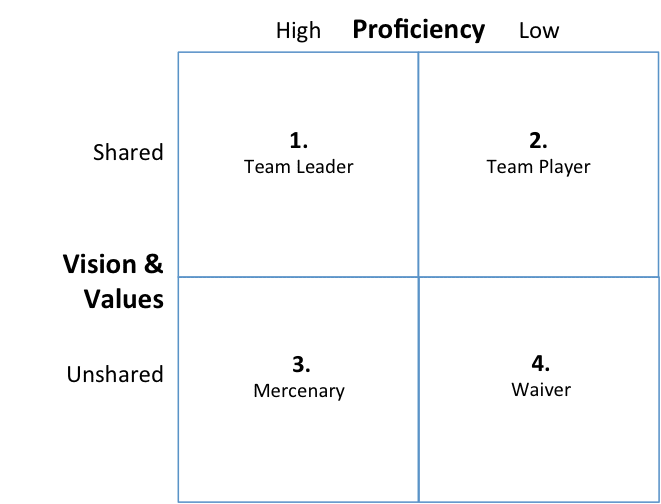Summary Insight:
If your company is misaligned on vision and values, it’s not a disagreement—it’s a ticking time bomb. This article shows how to spot the cracks and build a culture that rows in sync and scales fast.
Key Takeaways:
- Vision is where you’re going. Values are how you travel.
- Misaligned vision and values demand decisive action—not compromise.
- Use the Vision & Values Matrix to identify, coach, or cut with clarity.
There are few things that will destroy momentum within an organization like a conflict in vision and values. This article will explain why this is so, what to do if you have a conflict of vision and values, and how to align or realign a shared sense of vision and values throughout your organization. First, allow me to define what I mean specifically by vision and values.
Making Sense of Vision and Values
Vision is the destination or ultimate outcome the organization is collectively working towards. For example, imagine that you’re a sea captain. Vision would be the destination and outcomes you’re seeking from a successful voyage. Are you sailing to Tahaiti or Vancouver? And what do you hope to gain from a such a voyage? Knowledge? Treasure? Experience? Or simply a ride to a new place? If vision is the destination, then values are the norms of behavior that are deemed acceptable during the voyage. What kind of ship would you run? Would it be clean, orderly, and tight? Or would you sail like a loose band of pirates, with the only moral code to win treasure or walk the plank? How the work is done reveals the values you espouse.
The same concepts hold true for your company. To be effective, an organization needs a shared and compelling vision so that everyone buys into where the organization is sailing and why. The crew has bought into the vision; they understand their role on the voyage; and they’re eager and determined to make it happen. A company also must embody a shared code of values so that everyone is clear on the modes of acceptable behavior and, more importantly, what isn’t acceptable behavior — the kind that will get you walking the plank. Without a compelling vision and clear authentic values, a company will tend to flounder like a ship adrift at sea. It’s just not going to get very far very fast.
What Happens if There’s a Conflict of Vision and Values
A true conflict of vision and values is an extreme situation that can’t be negotiated. That is, if two or more people possess conflicting vision and values, then one of them must go (yes, that means leave the organization). Intuitively, this should make sense. For how can two groups of people get along and work together if they want to head in opposite directions or don’t value the same conduct? For example, if a couple no longer share the same vision and values for their relationship, no amount of counseling is going to save it. It’s best for both parties to part ways and find partners who do share their vision and values. Likewise, if two company co-founders have a genuine conflict of vision and values, one should buy out the other or they should agree to shut the company down. The organization is just not going to make it while that conflict exists. On a global scale, we have seen plenty of conflicts of vision and values in action. Communism and capitalism are perhaps the most flagrant 20th century examples. In cases like this, if one imposes itself on the other, the resistance to change is so great that this usually results in war. Conflicting vision and values are the major reason why peace between Israel and Palestine is so hard to negotiate. Both sides have a fundamentally different vision and values around co-existence. Until that conflict is resolved, no peace treaties, walls, terrorism, or sanctions are going to bring the sides together. However, with shared vision and values, all other conflicts become manageable.
Because it’s so extreme, your best course of action when you suspect a potential conflict of vision and values is to prevent that conflict in advance. There’s an old saying that when the head is rotten, it affects the whole body. Put another way, vision and values tend to flow from the top of the organization down. Therefore, you want to be extra vigilant that those in leadership positions have bought into a common set of vision and values and actually walk the talk. When this occurs, by their very presence, they naturally instill shared vision and values and help to cascade them throughout the organization. Here’s how you accomplish this.
How to Align Vision & Values

The Team Leaders in Quadrant 1 are those individuals who exemplify the best that your organization can be. They walk the talk. They embody the desired vision and values of your organization and, at the same time, they have a very high level of proficiency (e.g. their skill in sales, marketing, finance, programming, etc.). Think of them like your starters or team captains. When it comes to managing starters, you want to develop their capabilities and career paths for the long term. This is a strategic investment and a smart one. Your job as manager is to help them cultivate their own leadership qualities and find the career path that is most engaging and rewarding to them. Celebrate and honor this group. Include them in strategic planning and the new hire process. They can set the tone and tempo for your entire organization.
The Team Players in Quadrant 2 includes those individuals who exemplify the desired culture of your company but who don’t perform at the same level of proficiency as the starters. Think of them like your bench. When it comes to managing the bench, your job is to coach them and train them to improve their proficiency for the task at hand. Invest time, energy, and attention in this group for results today. It is relatively easy to develop proficiency in the short run but it is very, very challenging to develop character in the long run. You either have it or you don’t. Therefore, value those in Quadrant 2 and coach them in technical proficiency.
The Mercenaries in Quadrant 3 are those who perform technically at a very high level but who don’t align with the company’s vision and values. This is like a group of mercenaries or free agents. They are in the game only for themselves and everyone knows it. Be careful with this group. Use mercenaries sparingly and in areas that are non-critical for the business but require a specialized skill. But at all costs, do not put mercenaries in leadership positions. If you do, this will have an adverse effect on the entire culture. When it comes to managing free agents, your job is to motivate and create incentives that reward short-term performance. Pay them cash on the barrelhead for a job well done. But do not attempt to win them over by offering a career path, an equity stake, or a leadership position that unduly influences others.
The Waivers in Quadrant 4 include those who don’t perform at a high level and don’t share the desired vision and values of the company either. If this was a sports team, this is the group that you’d place on the waiver wire and hope to trade to your competition. There’s no real point in investing time, energy, and attention in improving skills or attempting to create a shared sense of vision and values. In other words, you can put lipstick on a pig, but it’s still a pig. Do yourself and that person a favor: help them find a new job with a different company that better aligns with their talents, vision, and values. You’ll both be better off.
Using a simple model like this matrix can help you quickly group the types of people in your organization and develop a short- and long-range plan to develop each one. It also brings tremendous clarity in identifying the types of starters you want to attract and what it takes to develop your bench. It also shows you the types of free agent mercenaries who you can use for selected tasks but that you shouldn’t count on to be around for the long term. Finally, this brings clarity to your waiver wire and the types of people who aren’t a good fit for your organization’s culture.
Remember, nothing creates greater misalignment in an organization and slows execution speed than a conflict of vision and values. Therefore, attempt to avoid misalignment by being clear and committed to a powerful vision and authentic values up front. Then fill leadership positions in your team with individuals that intrinsically share that same vision and core values. If you can do this, you’ll have smooth sailing ahead. But if you make the mistake of hiring people who don’t buy into the vision and values, you’ll end up facing mutiny or forcing key members to walk the plank.
Back to Tutorials.





